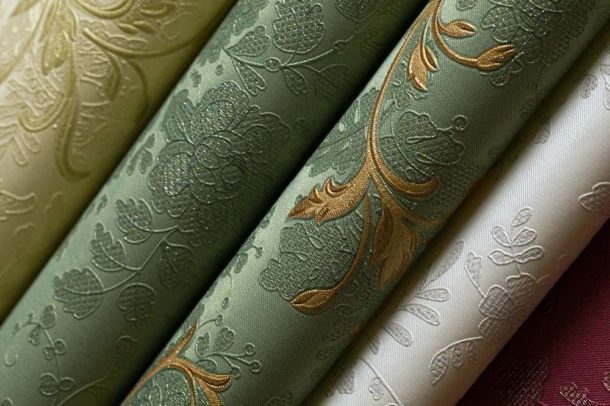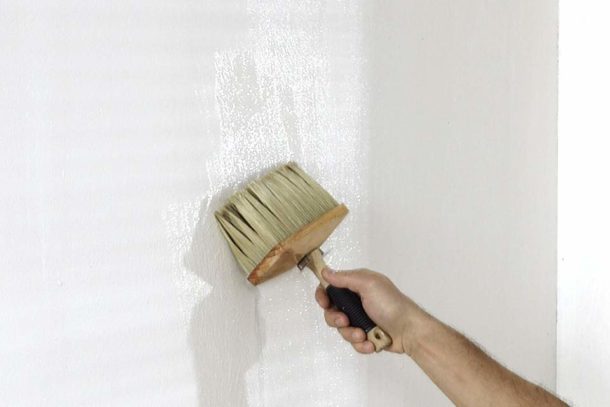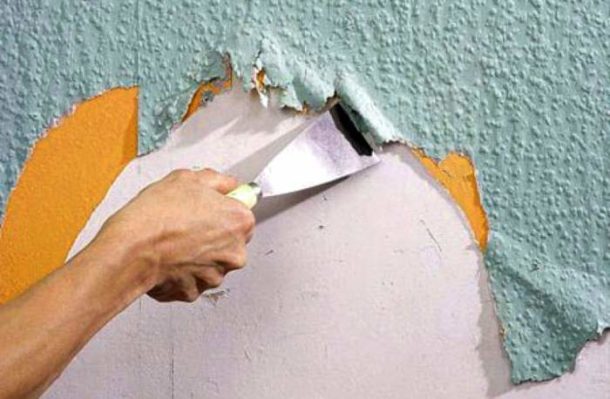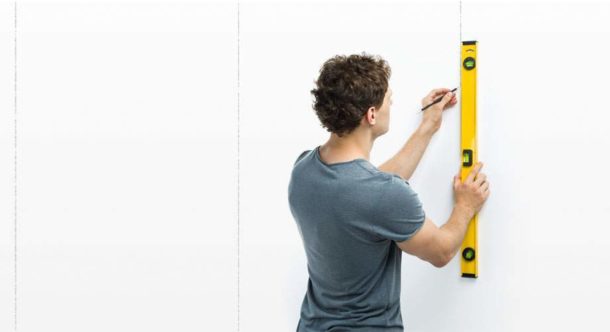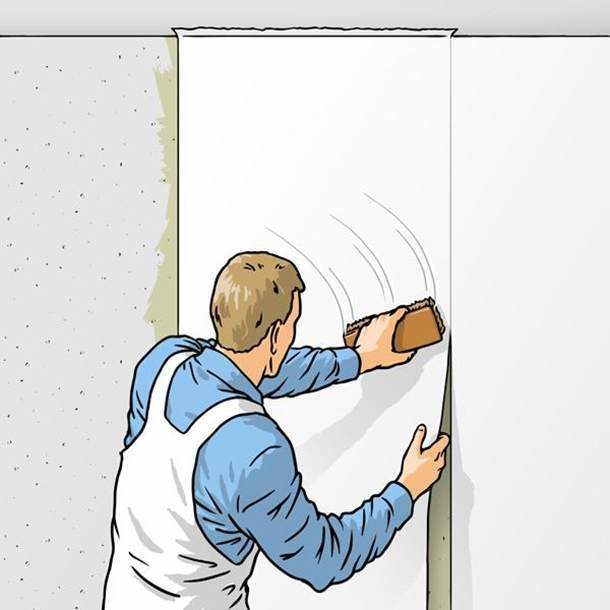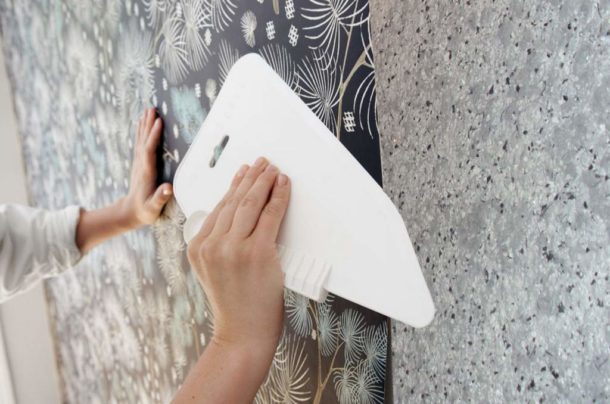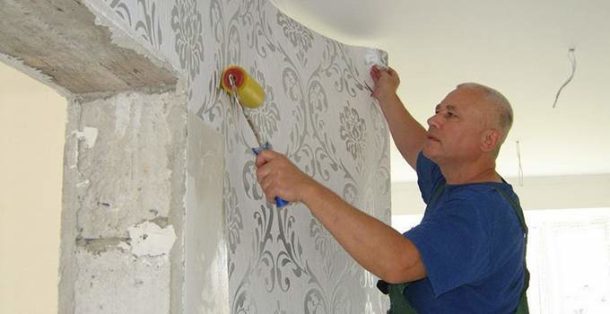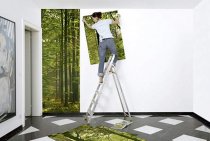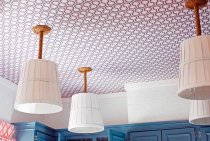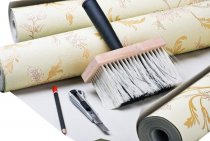Among the many options for wall decoration, wallpaper occupies a leading position. They come in a wide variety of styles, textures, designs and colors. The most practical option is non-woven fabrics, with which the gluing process is greatly simplified, small flaws and irregularities of the base surface are hidden. Gluing non-woven wallpaper is not at all difficult, we suggest understanding the intricacies of this process.
Types of non-woven wallpaper
Almost any hardware store can offer a whole range of wallpapers containing interlining:
- Fully non-woven. Moisture and fire resistant, poorly flammable, strong, durable, airtight type of canvases. Can be single or multilayer. A common version of non-woven wallpaper, designed for painting after pasting or decoration.
- Paper on a non-woven basis. Differ in high air permeability, low price. Thanks to rolling through a press, they have three-dimensional patterns.
- Vinyl on non-woven backing. A PVC coating is applied to the substrate, which allows you to create unique textures, an abundance of patterns. The surface can be foamed or hard, which determines the relief and density. Such wallpapers are immune to sunlight, mechanical damage, moisture, but they do not pass air well.
- Textile on non-woven base. The role of the top cover is natural linen, cotton, silk. In addition to the original, aesthetically attractive appearance, they provide additional sound insulation, and the joints of the strips are invisible.
- Hot stamping wallpaper. A subspecies of vinyl canvases based on non-woven fabric. The use of a special technology allows you to create volumetric patterns that mimic fabric or leather. An example of such a finishing material is in the photo below.
Features of working with non-woven wallpaper
Before starting pasting, we recommend that you familiarize yourself with some of the characteristic features of the described type of wallpaper.
- The surface of the walls must be leveled, have a single color, otherwise you can spoil the appearance of the finished finish. By the way, if the wall is a little uneven, thanks to the dense structure of the wallpaper, such a flaw can be hidden.
- The adhesive composition is applied only to the surface of the wall. So it is possible to significantly speed up and simplify the work, reduce the consumption of glue.
- It is necessary to stick wallpaper strips end-to-end, without overlap. So, it is possible to create a single canvas, on which there will be no bulges and seams. If there is a pattern on the material, it is important to monitor its coincidence.
Due to the fact that non-woven wallpaper rolls are often produced wide (up to 140 cm wide), the number of seams is minimized.
Tools and materials
Before you start the process of pasting wallpaper with a non-woven base, you need to take care of the availability of certain improvised means. For work you need to prepare:
- convenient wallpaper spatula for leveling pasted strips;
- rubber roller;
- several brushes of different sizes for applying glue to the wall;
- adhesive composition designed for the selected type of wallpaper;
- a container of a suitable volume for diluting glue;
- a brush with which wrinkles are smoothed;
- construction knife;
- clean sponge;
- plumb or flat bar;
- nozzle-mixer on a drill;
- a marker or pencil capable of writing on the surface of the wallpaper;
- sharp scissors.
Proper wall preparation
In order for the newly created interior to serve in good faith, a number of preparatory measures must be carried out:
- We remove the old finish, clean the wall from dirt and dust. This is especially important if it has a dark color or a bright pattern.Rules for removing different types of coatings - in this article. Methods for removing paint - here.
- We level the surface of the walls, clean the potholes, chips and cracks with sandpaper. We cover the work surface with putty. When choosing a wide wallpaper fabric, this is done especially carefully, otherwise it will not work to join the strips evenly.
- To improve adhesion, prevent the formation of mold after the putty dries, the walls are covered with a deep penetration primer. Further work can be started only after it dries.
The preparation steps are described in detail in this article, drywall is prepared according to the rules that can be found here.
If we are talking about gluing textile wallpapers so that the surface does not differ from them in tone, it is recommended to use a waste paper substrate. Glue it horizontally so that the joints of the lining are not visible through the wallpaper.
Wall marking and wallpaper preparation
We recommend starting the markup from the most inconspicuous corner. If wallpaper is purchased with a width of 106 cm, measure 104 cm from the corner and draw a vertical line along the marks. It will become a guide for attaching the first of the strips.
On the drawn line, we measure the distance between the ceiling and the floor. Using sharp scissors or a clerical knife, cut off the wallpaper strip of the appropriate length. It is better to immediately perform cutting, given the need to combine the pattern.
Sticking technology
Work is performed in the following sequence:
- Lubricate the rectangle marked on the surface of the wall with adhesive. We do it carefully, without omissions. A thicker layer should be applied to the corners.
- Glue the first strip. It must be dry. We make sure that its edge clearly coincides with the drawn line. A small overlap is made on the ceiling baguette.
The presence of a gap between the floor surface and the wallpaper is considered non-critical; it will close with a plinth.
- Use a clean rag or plastic spatula to press down the wallpaper. Smoothing movements are performed from the center to the edges, starting from the ceiling and gradually moving lower.
- Similarly, we glue the remaining strips, focusing on the edges of the previous sheets. By shifting the sheets, we eliminate the cracks and overlays that have appeared. To remove excess glue, use a soft sponge, do not let it harden.
Non-woven wallpaper slides over the glue and does not wrinkle. After applying the canvas to the wall, it can be easily leveled and corrected for at least 10 minutes without compromising the quality of gluing.
Corner wrapping
In any room, corners are considered a difficult and tricky place. Due to the fact that the walls are not always clearly perpendicular, you have to go to tricks to match the pattern. The best option is to create an overlap with cutting through both canvases. For perfect execution, we recommend watching the following video.
Sticking in difficult places
There are some features when working with difficult areas - windows, doorways, arches, air conditioner installation sites. For pasting them, blanks of the desired shape are cut out. When measuring, it is advisable to add a few centimeters for cutting.
After complete drying of the wallpaper, finishing processing is carried out. With a clerical knife, using a spatula that acts as a ruler, cut off the excess on the baseboards, in the openings.
Holes for sockets and switches are cut crosswise, the edges are bent, excess pieces are cut off with sharp scissors.
If in some places the canvases are lagging behind, they should be carefully glued.
The process of sticking wallpaper on non-woven fabric is simple, it is much easier to work with them than with paper counterparts. Even a non-professional can do everything right.It is important to carefully cut the material, coat the wall well with glue, and pay special attention to the corners.

